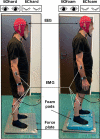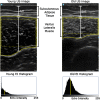Age-related changes in ultrasound-assessed muscle composition and postural stability
- PMID: 39134635
- PMCID: PMC11319795
- DOI: 10.1038/s41598-024-69374-8
Age-related changes in ultrasound-assessed muscle composition and postural stability
Abstract
While the simultaneous degradation of muscle composition and postural stability in aging are independently highly investigated due to their association with fall risk, the interplay between the two has received little attention. Thus, the purpose of this study is to explore how age-related changes in muscle composition relate to postural stability. To that aim, we collected posturography measures and ultrasound images of the dominant Vastus Lateralis and Biceps Brachii from 32 young (18-35 year old) and 34 older (65-85 year old) participants. Muscle properties were quantified with echo-intensity and texture-based metrics derived from gray-level co-occurrence matrix analysis, and postural stability with the variability of the center of pressure during bipedal stance tasks. Ultrasound parameters revealed that young muscle possessed lower echo-intensity and higher homogeneity compared to the elderly. Echo-intensity and muscle thickness, and several texture-based parameters possessed outstanding young versus older classification performance. A canonical correlation analysis demonstrated a significant relationship between ultrasound and postural measures only within the young group (r = 0.53, p < 0.002), where those with 'better' muscle composition displayed larger postural sways. Our results indicate that, in older individuals, postural stability and muscle composition, two common fall risk factors, are unrelated. In view of this decoupling, both may contribute independently to fall risk. Furthermore, our data support the view that texture-based parameters provide a robust alternative to echo-intensity in providing markers of muscle composition.
© 2024. The Author(s).
Conflict of interest statement
The authors declare no competing interests.
Figures





References
MeSH terms
Grants and funding
LinkOut - more resources
Full Text Sources
Medical

